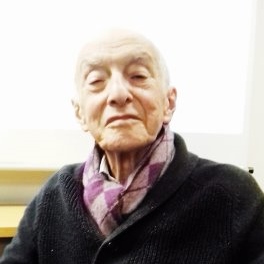click to dowload our latest edition
CLICK HERE TO SUBSCRIBE TO OUR NEWSLETTER


Published
5 years agoon
By
adminMOIRA SCHNEIDER
With this question, Richard Glasstone introduced his talk on his memoir, Congo to Covent Garden: A life linked by languages, hosted by the Jacob Gitlin Library and the SA Jewish Museum.
Glasstone is an internationally recognised master ballet teacher, choreographer, and dancer, and was awarded an MBE (Member of the Most Excellent Order of the British Empire) in 2013 for services to classical ballet.
He related how his grandfather escaped the pogroms in Lithuania, and found his way to Edinburgh, where his uncle Reuben and father, Harry, had been born. Reuben decided to seek his fortune in Africa, and borrowed 10 pounds (R186) for the trip to Cape Town, where he worked his way doing odd jobs.
Harry joined him at the age of 17, and the two ended up running a general store in Broken Hill, in then northern Rhodesia (Zambia). With the discovery of copper in the Congo (now the Democratic Republic of the Congo), Reuben made his way there, leaving his brother in charge of the shop.
On his arrival in 1910, he was confronted with what he described as the wild west. There, he pitched his tent in driving rain, and later sent for Harry. Reuben opened a general store there too.
While holidaying in the Cape, he met and married a girl from Oudtshoorn. Tragically, they lost two sons: the eldest as a result of an infection from his circumcision, the first Jewish child to die in the Congo.
A second son died of rheumatic fever. After this double blow, the couple left the Congo for Cape Town with their remaining son, Victor. Reuben, in fact, built a shul in Elizabethville in memory of his second son, Reginald.
Glasstone’s father took over the business, La Maison Glasstone, which he said was “very famous” in the Congo.
Richard himself was born in the Congo. While holidaying in Muizenberg, he met a girl on the beach who said she wanted to go to the ballet. “I’d never been to the ballet,” he commented.
“The first one, Swan Lake, didn’t interest me,” he recalled. But “I was absolutely enchanted by the second one, Giselle, and the fact that you could tell a whole dramatic story by dancing and acting. I decided then and there that this was what I wanted to do.”
He came to Cape Town to complete his education, and approached Dulcie Howes about attending the ballet school attached to the University of Cape Town that she had founded. As a teenager, he found himself “the only tall, skinny boy in a class of eight-year-old girls”.
“When my father heard I was doing ballet in Cape Town, he thought I was meshuggah (crazy),” Glasstone recalled. But Howes had written to him and seemingly pacified him.
Showing improvement, he was promoted to the next class where there was another boy, John Simons, who was to become a Capab (Cape Performing Arts Board) ballet star. “He helped me with my pirouettes,” Glasstone remembered.
At the end of his first year of a three-year teacher’s course at the school, Glasstone’s father passed away. My sister said, “Enough ballet, come home already!”
But his mother, Rosie, prevailed, saying, “Leave him.” Glasstone was later appointed a junior lecturer at the University of Cape Town ballet school.
Glasstone’s career took off internationally with his first job in Holland. He later moved to London with a letter of introduction from Dulcie Howes to Dame Ninette de Valois, who established the Royal Ballet and is regarded as one of the most influential figures in the history of ballet.
“I’ve got nothing for you – would you go to Turkey?” she had said. As a result, he spent “three wonderful years” in Turkey, where he was the resident choreographer and principal teacher at the Turkish State Ballet Company, before being invited by De Valois to join the staff at the Royal Ballet School where he worked for 15 years.
Glasstone’s first three-act ballet, Sylvia, was in fact commissioned by De Valois. He went on to direct the Istanbul State Ballet Company, and then joined the staff at the Rambert School of Ballet and Contemporary Dance in the United Kingdom.
He has written several books on ballet, and has contributed articles to the International Encyclopedia of Dance and the International Dictionary of Ballet, the Dancing Times and Dance Now.
Glasstone paid tribute to his three mentors, Dulcie Howes, Ninette de Valois, and Hans Snoek, the Dutch dancer, choreographer, and ballet director who founded the Scapino Ballet as “three practical women who guided me in my career”.
Glasstone, now 84, has been married for 55 years to Heather Magoon, an art student whom he met when she designed the poster for his first production in Cape Town. She later designed costumes for him.
They were married at the Gardens Synagogue by Chief Rabbi Israel Abrahams.
“The secret is you have to have a row every day,” he told the audience.
